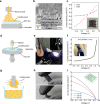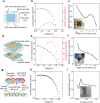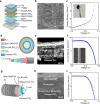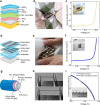Advances in Smart Photovoltaic Textiles
- PMID: 38261716
- PMCID: PMC10851667
- DOI: 10.1021/acsnano.3c10033
Advances in Smart Photovoltaic Textiles
Abstract
Energy harvesting textiles have emerged as a promising solution to sustainably power wearable electronics. Textile-based solar cells (SCs) interconnected with on-body electronics have emerged to meet such needs. These technologies are lightweight, flexible, and easy to transport while leveraging the abundant natural sunlight in an eco-friendly way. In this Review, we comprehensively explore the working mechanisms, diverse types, and advanced fabrication strategies of photovoltaic textiles. Furthermore, we provide a detailed analysis of the recent progress made in various types of photovoltaic textiles, emphasizing their electrochemical performance. The focal point of this review centers on smart photovoltaic textiles for wearable electronic applications. Finally, we offer insights and perspectives on potential solutions to overcome the existing limitations of textile-based photovoltaics to promote their industrial commercialization.
Keywords: electronic textiles; energy harvesting; green energy; photovoltaic textiles; smart textiles; solar cells; solar energy; wearable electronics.
Conflict of interest statement
The authors declare no competing financial interest.
Figures



















References
-
- Libanori A.; Chen G.; Zhao X.; Zhou Y.; Chen J. Smart textiles for personalized healthcare. Nat. Electron. 2022, 5 (3), 142–156. 10.1038/s41928-022-00723-z. - DOI
-
- Zhao J.; Fu Y.; Xiao Y.; Dong Y.; Wang X.; Lin L. A naturally integrated smart textile for wearable electronics applications. Adv. Mater. Technol. 2020, 5 (1), 1900781 10.1002/admt.201900781. - DOI

